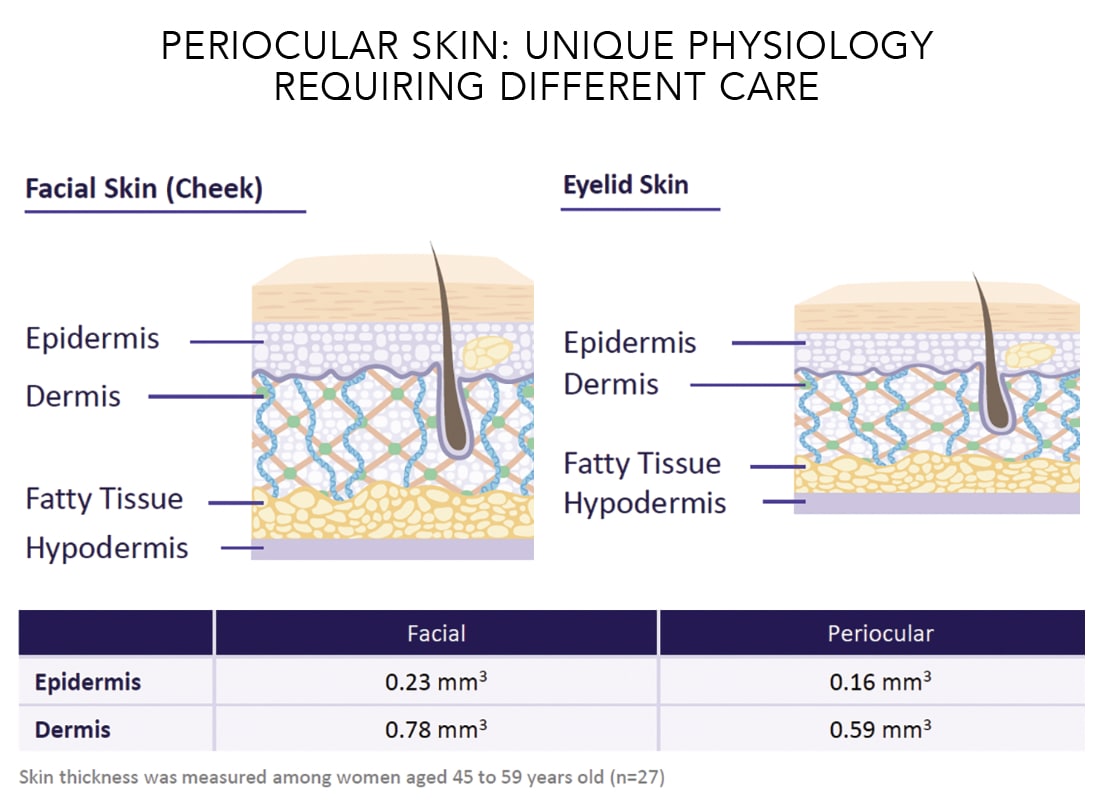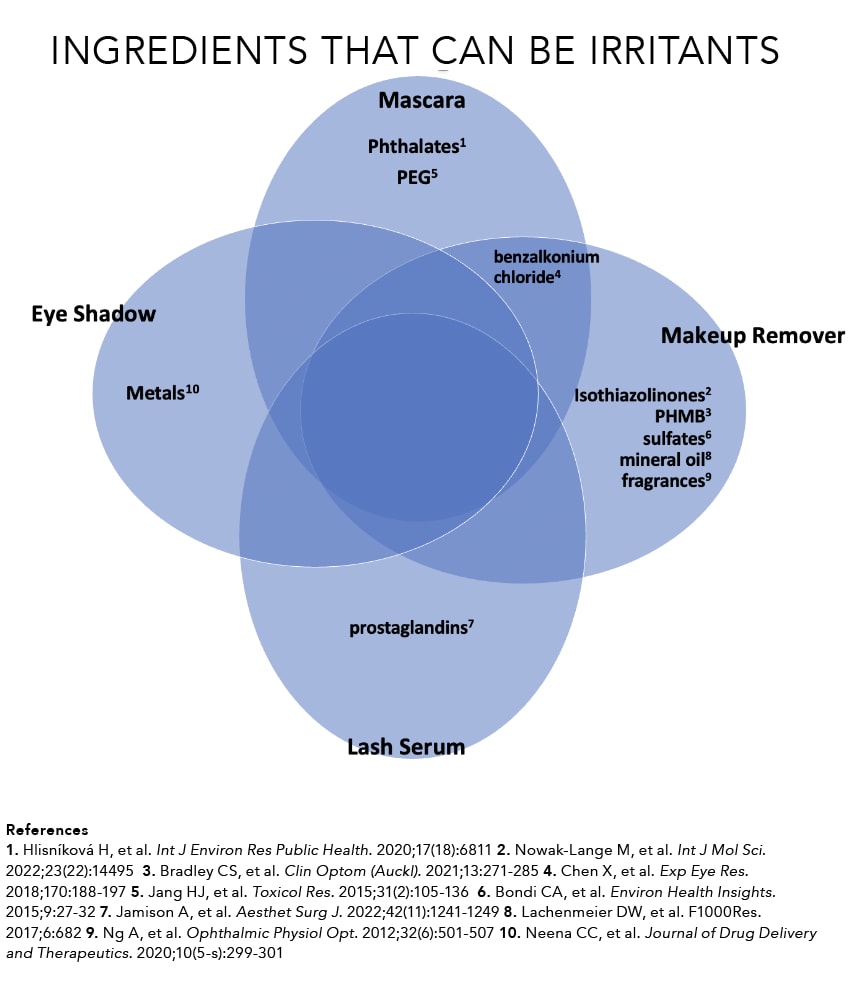Most patients are unaware of the unique makeup of the skin around their eyes, and that it requires special care. The skin in this region is the thinnest on the body, meaning without the proper treatment, it is at risk for premature aging and even skin cancer. As eyecare practitioners, it is important to begin educating patients on how to best protect the area, from using the right kind of sunscreen to properly managing makeup routines.
Dr. Wesley: It’s important to educate patients on where to apply makeup,
how to apply it, and how to remove it, as it makes a huge impact on the anterior segment as well as a patient’s overall comfort. Many of the products out there could be damaging the fatty tissue in, around, and under the eye, causing premature aging, damaging their meibomian glands, and ultimately affecting the anterior surface.
Dr. McGee: It’s also important that we ask the right questions. I often find that my patients won’t ask unless I ask first.
Dr. Periman: The question that always comes up for me is, “Doctor, what do you recommend?” There’s a high bar for making a recommendation for a product. That’s been the impetus of my journey for the last 20 years.
Dr. Said: We need to remember that by not educating our patients about beauty products, we’re approving behaviors or products that might not be good for the eye. If the doctor doesn’t say something about it, they think it must be okay. But it’s not.
Dr. Wesley: I have frequent conversations with my patients about makeup application, specifically regarding tight lining. Most will come back and say, “My eyes feel so much better. I just didn’t know that it was something I shouldn’t be doing.”
Skin around the eye
- Contains less collagen and elastin compared to the rest of the face1
- More susceptible to physiological aging, including collagen loss and thinning of the skin2
Eyelid skin
- The thinnest skin in the body (could be 0.2mm)2
References
1. Cheng L, et al. Chinese Journal of Plastic and Reconstructive Surgery. 2021;3(4):218-223. 2. Pilkington SJ, et al. J Clin Aesthet Dermatol. 2015;8(9):39-47. 3. Meng Y, et al. BMC Med Imaging. 2022;22(1):113.
Not All Beauty Products Are Created Equal
With a seemingly limitless variety of eye cosmetics available to patients, eyecare professionals can help patients choose products that are best for their eye health and periocular skin. Not all products are created equal. Expand your discussion about makeup and skincare products to include specific ingredients to avoid (see sidebar). Encourage patients to look for products specially formulated and tested for the eye area.
By contrast, there are several beneficial ingredients that patients should be on the lookout for when shopping for cosmetics and eye skincare products.
Dr. Said: The ingredients caffeine, vitamin C, and vitamin E have all shown that they can tighten skin and improve appearance. But it's important to consider if these products have been clinically tested or vetted properly to ensure that they are safe and effective.
Dr. McGee: Hyaluronic acid is a good one. As well as niacinamide. All of these have been demonstrated in peer-reviewed literature to have skin benefits.
Ingredients That Can Nourish the Eye
These ingredients have demonstrated benefits to the facial skin, particularly close to the eye.
- Caffeine: Enhances the appearance of dry skin.1
- Hyaluronic Acid: Enhances the appearance of dry or damaged skin.1
- Niacinamide: Reduces appearance of skin aging.2
- Peptides: Reduce appearance of wrinkles.3
- Vitamin C: Reduces appearance of wrinkle depth, has antioxidant properties.4-5
- Vitamin E: Reduces appearance of skin aging.4
References
1. Cosmeticsinfo.org 2. Liu JK, et al. Nat Prod Bioprospect. 2022;12(1):40. 2. EunLee K, et al. J Enzyme InhibMed Chem. 2019;34(1):927-936. 3. Jeong S, et al. Int J Mol Sci. 2019;21(1):73. 4. Pullar JM, et al. Nutrients. 2017;9(8):866. 5. Michala KM, et al. Nutrients. 2021;13(1):203.
Patient Tips for Healthier Eyes
Read on for helpful pieces of advice from our panelists to share with patients when it comes to healthier, beautiful-looking eyes.
- Allergic reactions and hypersensitivities aren’t always immediate. Some ingredients build up over time before a reaction shows around the eyes.
- Check out all the ingredients in your products. Key ingredients like aloe vera and hyaluronic acid are great, but it’s the hidden ingredients down around number 25 that can be causing your issues.
- Encourage your patients to ask—about the right products and the right habits. The right knowledge will keep their eyes healthier.
- It’s not just women who should care about good ocular periorbital skin health. Encourage your male patients to also invest in a good lid wipe that can remove debris and allergens that lurk around their eyes.
- Don’t be fooled by the “dermatologist-tested” label when it comes to products around the eyes. It may be great for the face, but in the sensitive periocular area, it may just contribute to over-stripping, over-conditioning with the wrong ingredients and, potentially, ocular surface disease.
SPONSORED CONTENT





